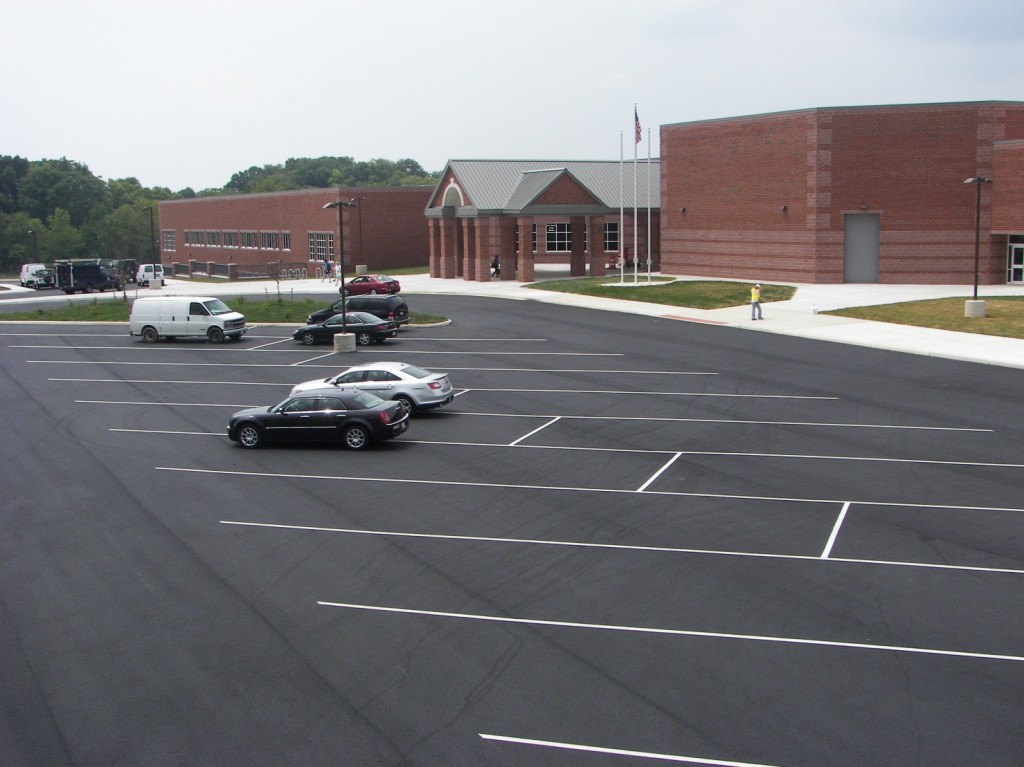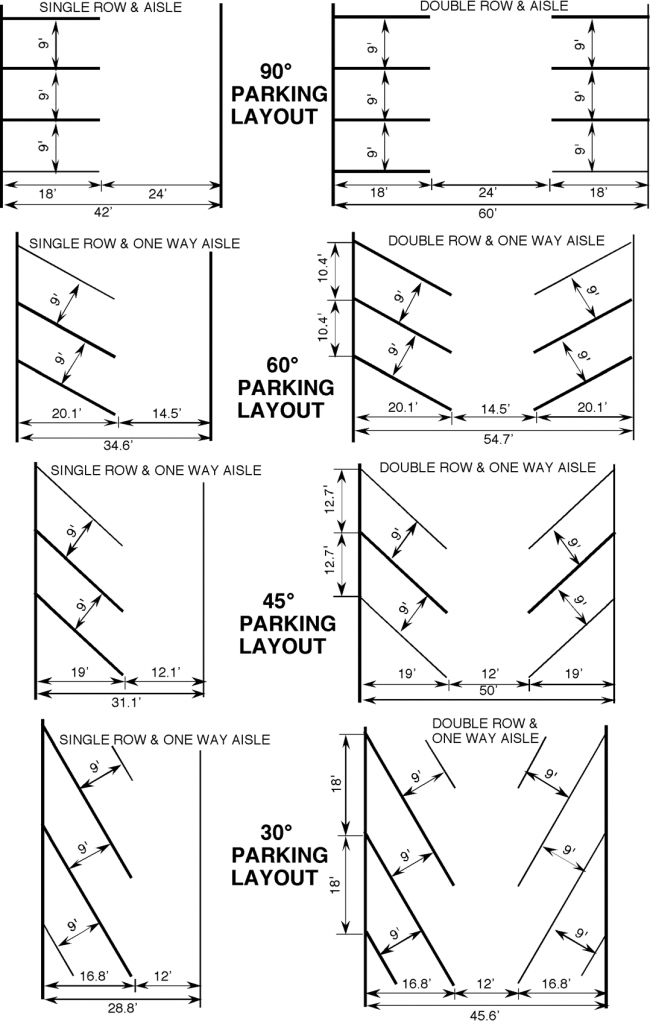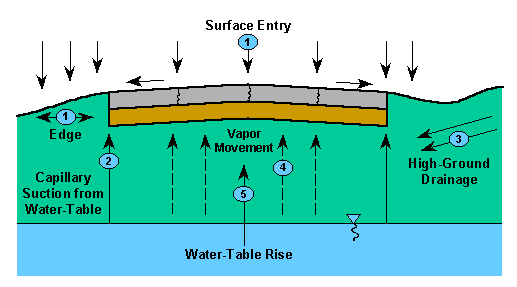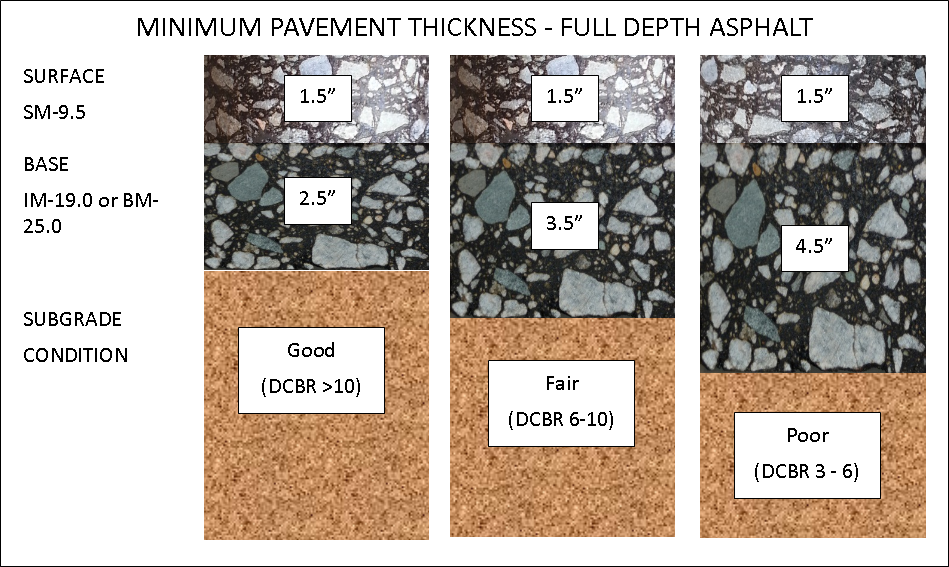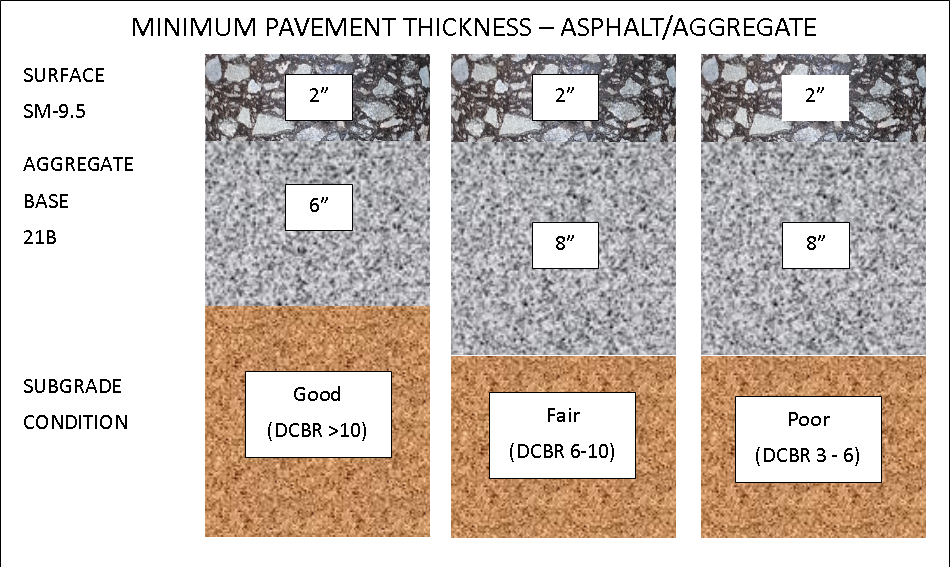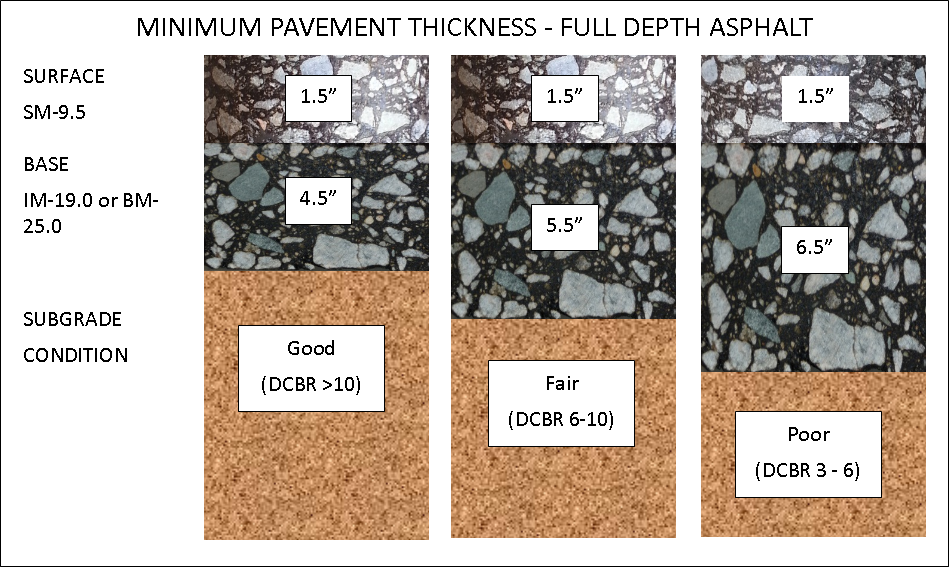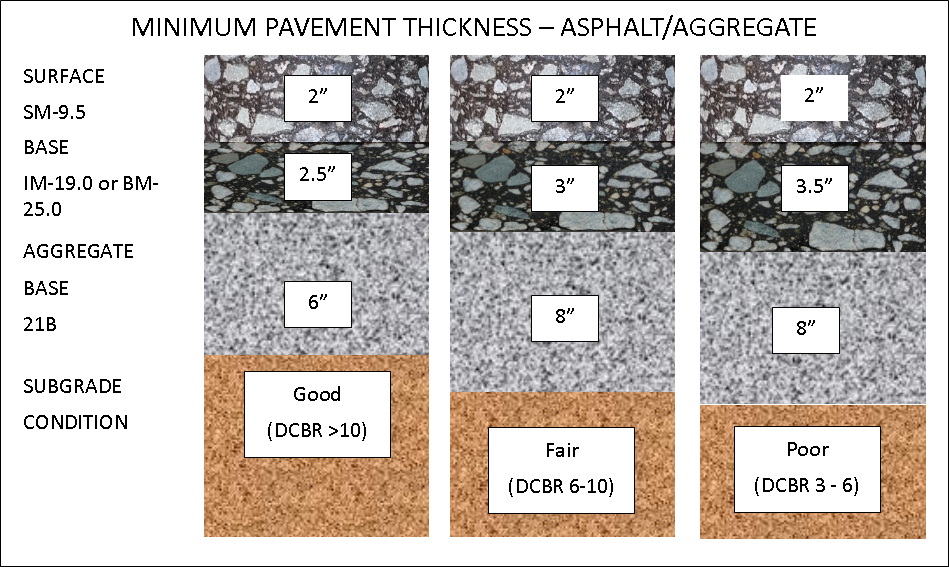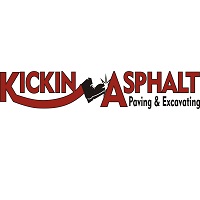 Please note – The primary objective of parking lot design is to provide safe, efficient vehicular access to parking stalls that serve businesses, commuter lots and residential facilities. For businesses and commuter lots, the design must consider the use of the pavement by buses, trucks and other heavy vehicles. This page addresses some basic considerations that should be evaluated in the design and construction of parking lots. Many localities have established certain standards and requirements for parking lots, as has the Virginia Department of Transportation. All applicable sections of these state and local requirements should be followed. The information contained herein is provided as an additional reference source for basic design and construction considerations. Most developers enlist the services of an architect or professional engineer because they want their new facility to be attractive, well designed, and functional, whether it is a new shopping center, business offices, school, or apartment complex. Many long hours are spent developing aesthetically pleasing designs that range in architectural style from Williamsburg Colonial to ultra-modern.
Please note – The primary objective of parking lot design is to provide safe, efficient vehicular access to parking stalls that serve businesses, commuter lots and residential facilities. For businesses and commuter lots, the design must consider the use of the pavement by buses, trucks and other heavy vehicles. This page addresses some basic considerations that should be evaluated in the design and construction of parking lots. Many localities have established certain standards and requirements for parking lots, as has the Virginia Department of Transportation. All applicable sections of these state and local requirements should be followed. The information contained herein is provided as an additional reference source for basic design and construction considerations. Most developers enlist the services of an architect or professional engineer because they want their new facility to be attractive, well designed, and functional, whether it is a new shopping center, business offices, school, or apartment complex. Many long hours are spent developing aesthetically pleasing designs that range in architectural style from Williamsburg Colonial to ultra-modern.
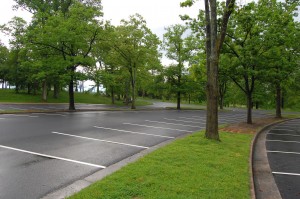 Unfortunately, all too often, the important functions of the new facility’s parking area are overlooked. Not only is the parking area the first part of a building complex seen by the user, it is the gateway through which all customers, potential customers, employees, visitors, and others pass. This first impression is quite important to the overall feeling and atmosphere conveyed by the new facility.
Unfortunately, all too often, the important functions of the new facility’s parking area are overlooked. Not only is the parking area the first part of a building complex seen by the user, it is the gateway through which all customers, potential customers, employees, visitors, and others pass. This first impression is quite important to the overall feeling and atmosphere conveyed by the new facility.
When properly designed and constructed, parking areas can be attractive, safe, and above all, easily and efficiently usable. In addition, they should be designed for low maintenance costs and ease of modification for changes in patterns of use.
The information contained in this chapter will provide a general guide to proper parking area design, construction, and facility layout. Minimum pavement thickness designs are given for both small parking areas (50 passenger car stalls or less) and larger facilities (over 50 passenger car stalls). In addition, comparable designs are given for both full-depth asphalt pavement (pavements using asphalt concrete for both base and surface courses) and asphalt over an aggregate base.
Parking lots are paved areas intended for vehicle parking and can vary widely in size, function, and design. Parking lots serve businesses, schools, commuters and other functions. The types of vehicles that use a parking lot vary. Some lots have primarily car traffic, but some have buses and trucks that deliver goods or transport people. These heavier vehicles are usually isolated to specific parts of the lot or travel the same path in the lot. This page gives some general guidance when designing at-grade parking lot pavements.
Design Considerations
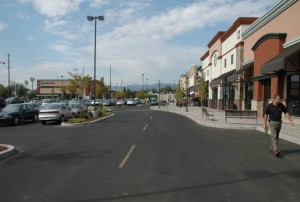 Most pavement designs are based on the traffic using the road when the construction is completed. However, with the construction of parking lots, the heaviest traffic using the majority of the parking lot is during the construction phase. Once the parking lot is completed, cars will be in the parking stall areas and trucks or buses will be in identified drive lanes or ring routes. Therefore, the pavement structure must be selected based on the construction traffic and sequence of construction. These pavements are generally built in phases. The first phase is the laying of the aggregate sub-base and asphalt base layers on the prepared subgrade or laying an asphalt base layer directly on the prepared subgrade. Because of the heavy trucks, pavement failures are not unexpected. However, once the construction has been completed, these areas are repaired and the final pavement surface is placed.
Most pavement designs are based on the traffic using the road when the construction is completed. However, with the construction of parking lots, the heaviest traffic using the majority of the parking lot is during the construction phase. Once the parking lot is completed, cars will be in the parking stall areas and trucks or buses will be in identified drive lanes or ring routes. Therefore, the pavement structure must be selected based on the construction traffic and sequence of construction. These pavements are generally built in phases. The first phase is the laying of the aggregate sub-base and asphalt base layers on the prepared subgrade or laying an asphalt base layer directly on the prepared subgrade. Because of the heavy trucks, pavement failures are not unexpected. However, once the construction has been completed, these areas are repaired and the final pavement surface is placed.
 Many parking areas are initially under designed, resulting in excessive maintenance problems and a shorter pavement life. The thickness designs given on this page are minimum thickness values. Any reduction of these values for base or surface thicknesses may cause severe pavement failure.
Many parking areas are initially under designed, resulting in excessive maintenance problems and a shorter pavement life. The thickness designs given on this page are minimum thickness values. Any reduction of these values for base or surface thicknesses may cause severe pavement failure.
Special truck lanes are sometimes required to expedite traffic to loading areas, trash dumpsters, and equipment areas. The design thickness for these lanes or any pavement areas carrying this type traffic should be increased. Drainage problems are also a major cause of parking area pavement failure. Their significance warrants a special section on drainage problems, and it is recommended that the section is reviewed prior to selecting a pavement design either from this website or any other source.
General Planning
In developing the parking area plan, several important factors should be considered.
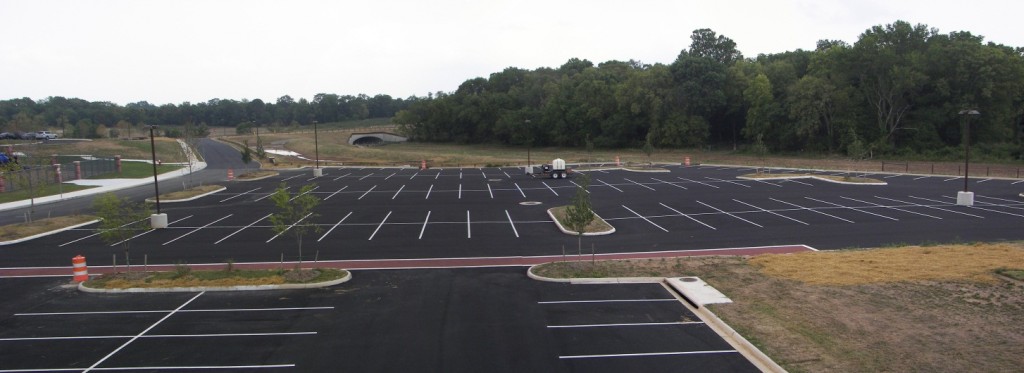
The primary consideration should be providing the maximum convenient parking capacity with the best use of available space. General recommendations for the required number of parking stalls are given in the table below. The following guidelines should provide optimum use of available parking area:
- Use rectangular areas.
- Make the parking area’s long sides parallel.
- Use parking stalls along the perimeter.
- Use traffic lanes that serve two rows of stalls.
Consideration should be given to the flow of traffic into and out of the area as well as within it. For safety and convenience, pedestrian traffic must also be taken into account when planning.
It should be noted that handicapped parking areas must also be provided at a location closest to the facility. For specific requirements related to handicapped parking areas, visit www.ada.gov.
Parking Angle
There are three basic parking angles used for the rows of parking area stalls; these are illustrated below. Sixty degrees (60°) is the most common stall angle because it permits reasonable traffic lane widths and is easy to enter and back out of. In tight places, the forty-five degree (45°) stall is sometimes preferred. The small change in angle permits the use of narrower aisles. On the other hand, the ninety degree (90°) angle achieves the highest car capacity. This type of parking is more suited to all-day parking (such as employee parking) because it has the highest degree of difficulty for entering and leaving parking stalls. It is generally not preferred for “in and out” lots such as fast food restaurants and banks. The following diagrams give a typical layout and dimension of a parking lot with parking angles of 45°, 60°, and 90° respectively.
Minimum Requirements
Individual parking stalls should be a minimum of nine feet by nineteen feet (9′ x 19′). However, special sections with slightly smaller stalls may be designated for compact cars to better utilize the area. Two-way traffic lanes have a minimum width of twenty-four feet (24′) and perimeter circulation road lanes should be thirty feet (30′). When the parking lot access opening is limited to less than thirty feet (30′) in width a separate entrance and exit should be used.
The minimum entrance radius is six feet six inches (66‘- 6″}. However, eleven feet six inches (11″- 6″) is recommended. The figure below provides a guide for determining the required layout and dimensions of parking lots for both single and overlapping units.
Rear overhang minimums depend on the stall angle. 45° stalls require three feet three inches (3′- 3″), 60° stalls require three feet nine inches (3′ -9″); and 90° stalls require four feet (4′).
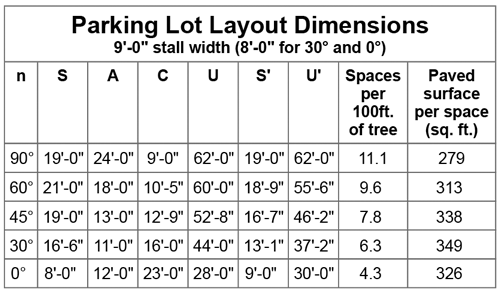
Drainage
Adequate pavement drainage is of great importance to all pavement designs. If the subgrade under the pavement becomes saturated, it will lose strength and stability and make the overlying pavement structure susceptible to break up under imposed loads. Both surface and subsurface drainage must be considered. All drainage must be carefully designed and should be installed in the construction process as early as is practicable. The pavement should also be constructed in a manner that will not permit water to collect at the pavement edge and provisions should be made to intercept all groundwater from springs, seepage planes, and streams. When used, curb and gutter sections should be set to true line and grade. Marshy areas will require special consideration and should be addressed during the planning stage.
Residential streets often are designed to follow natural drainage ways to permit rapid run-off from building lots. Both surface and subsurface drainage must be given careful attention to prevent accumulation of water. Where drainage is unusually difficult, it may be necessary to increase pavement thickness and install subgrade underdrains. (Underdrains are usually not required when full depth asphalt is used.)
Drainage impacts pavement performance when the subgrade materials and pavement layer materials are saturated and lose strength. Water that falls on the pavement surface must be drained to curb and gutter systems or ditches. Water that penetrates the pavement from the surface; infiltrates from the sides of the road, or rises from under the pavement should not be allowed to compromise the overall strength.
Many subdivision streets are placed at too low an elevation resulting in the pavement carrying run off and acting as a drainage facility. This results in increased maintenance and shorter pavement life. Proper elevation and crown are essential to pavement surface drainage.
To account for surface water drainage, it is important that the road is constructed with a crown or cross slope. Typically, a crown is placed in the center of the road and the pavement is sloped 2% in each direction. Occasionally, the pavement will be super-elevated where one side of the road is higher than the other. In either case, the pavement must be sloped to keep water from ponding on the surface.
For subsurface water, the approach to address varies based on the project. In some situations, underdrains are placed to intercept water that may flow under a pavement. This water is then allowed to flow out into a ditch or is put in a stormwater system. In many cases where the subgrade becomes weaker due to water, the subgrade is stabilized with a binding agent, removed and replaced with a stronger material, covered with a stabilization fabric prior to placing the next pavement layer or the next pavement layers are made thicker.
Subgrade Preparation
Because the subgrade must serve both as a working platform to support construction equipment and as the foundation for the pavement structure, it IS most important for the architect or engineer to see that it is properly compacted and graded. A visual examination will usually reveal the adequacy of the elevation. However, laboratory tests to evaluate the load-supporting characteristics of the subgrade soil are desirable. If these tests are not available, designs may be chosen based on careful field evaluations and previous projects and experience in the area.
All underground utilities should be protected or relocated prior to grading. All topsoil should be removed and low-quality soil must be improved by adding asphalt or other suitable admixtures such as lime or granular materials.
The areas to be paved should have all rock, debris, and vegetation matter removed and be treated with a soil sterilizing agent to inhibit future flora growth. Grading and compaction of the area should be completed in such a manner as to prevent yielding areas or pumping of the soil. The subgrade should be compacted to a uniform density of 95% of the maximum theoretical density.
Should a weak spot be discovered, the material should be removed and replaced with either six inches (6″) compacted crushed stone or three inches (3″) compacted asphalt concrete. In case of extremely poor subgrade, it may be necessary to remove the upper portion of the subgrade and replace it with a selected material. When finished, the graded subgrade should not deviate from the required grade and cross section by more than one-half inch (1/2”) in ten feet (10′).
Drainage Provisions
Drainage problems are frequently a major cause of parking area pavement failures. This is especially the case with irrigation sprinkler systems located in parking lot islands and medians. It is critical to keep water away from the subgrade soil. If the subgrade becomes saturated, it will lose strength and stability, making the overlying pavement structure susceptible to break up under imposed loads
The primary drainage function of parking lots is to convey minor storms quickly and efficiently to the storm sewer or open channel drainage with minimal impact on the vehicle/ pedestrian traffic and the surrounding environment. In addition, removing water quickly from paved surfaces will prevent water from reaching the subgrade, minimize cracks due to the weakened subgrade, and prolong the life of the pavement in a parking lot. Parking lot drainage requires consideration of surface drainage, gutter flow, inlet capacity, and inlet locations. The design of these elements is dependent on storm frequency and rainfall intensity.
When rain falls on a sloped pavement surface, part of it infiltrates into the ground, part of it evaporates into the air, and the remainder runs off from the high point to the low point as a result of gravity. The runoff water forms sheet flow – a thin film of water that increases in thickness as it flows to the edge of the pavement. Factors which influence the depth of water on the pavement are the length of flow path, surface texture, surface slope, and rainfall intensity.
Surface drainage for a parking lot consists of slopes, gutters, and inlets. Desirable gutter grades should not be less than 0.5 percent (0.005 ft/ft) for curbed pavements with an absolute minimum of 0.3 percent.
Water is probably the greatest cause of distress in a paved structure. The efficient removal of a storm runoff from paved surfaces has a positive effect on parking lot maintenance and repair. A minimum slope of 0.4 percent (0.004 ft/ft) shall be used for the paved surfaces. Parking lots with grades flatter than 0.4 percent are subject to ponding and are candidates for installing underground storm sewers. To achieve adequate drainage, a slope between 2% and 5% is recommended for paved surfaces in a parking lot.
Base Construction (Asphalt)
Prior to placement of the asphalt concrete base course, the subgrade should be graded to the established requirements, adequately compacted, and all deficiencies corrected. The asphalt concrete base course should be placed directly on the prepared subgrade in one or more lifts, spread, and compacted to the pavement thickness indicated on the plans or established by the owner. (Compaction of asphalt mixtures is one of the most important construction operations contributing to the proper performance of the completed pavement, regardless of the thickness of the course being placed. This is why it is so important to have a properly prepared subgrade against which to compact the overlying pavement.) The asphalt concrete should meet the Virginia Department of Transportation specifications.
Base Construction (Aggregate)
The subgrade must be graded to the required contours and grade in a manner as will ensure a hard, uniform, well-compacted surface. All subgrade deficiency corrections and drainage provisions should be made prior to constructing the aggregate base. The crushed aggregate base course should consist of one or more layers placed directly on the prepared subgrade, spread, and compacted to the uniform thickness and density as required on the plans or established by the owner. Absolute minimum crushed aggregate thickness is six inches (6″). All crushed aggregate material should be of Virginia Department of Transportation approved type and suitable for this type of application.
Tack Coat
Prior to placement of successive pavement layers, the previous course should be cleaned and, if needed, a tack coat of emulsified asphalt applied. The tack coat may be eliminated if the previous course is freshly placed and thoroughly clean.
Asphalt Surface Course
Material for the surface course should be an asphalt concrete mix placed in one or more lifts to the true lines and grade as shown on the plans or set by the owner. The asphalt concrete should conform to Virginia Department of Transportation specifications. The asphalt surface should not vary from established grade by more than one-eighth inch (1/8″) in ten feet (10′) when measured in any direction. Any irregularities in the surface of the pavement course should be corrected directly behind the paver. Rolling and compaction should start as soon as the asphalt concrete can be compacted without displacement and continued until thoroughly compacted and all roller marks disappear.
Curb and Gutter
Many parking facilities have some form of curbing around the perimeter for both functional and aesthetic reasons. The drawing below illustrates the three basic types of systems – concrete curb and gutter, asphalt curbs, and concrete curbs with sidewalks.
One of the most common errors in pavement design, however, is not specifying the appropriate grades to ensure that water does not collect on the pavement. Many parking facilities with curb and gutter have the elevation of the pavement below that of the curb and gutter. As water is the biggest enemy of any pavement, these “dry curbs” will result in poor pavement performance and shorter pavement life. Note: To function correctly curb and gutter should always be downslope from the pavement surface so the surface runoff from the pavement will drain into the gutter.
Truck Lanes for Loading, Dumpsters, etc.
The pavement for truck lanes used for loading, deliveries, etc., must be increased in thickness to prevent pavement failure due to the weight associated with heavy trucks. These areas should be constructed with asphalt pavement thicknesses that will support this heavier, pavement loading, typically a minimum of 3” of base asphalt under the surface course and over a 6”-8” aggregate subbase.
For areas where trash truck service waste containers and dumpsters special pads and approaches are required to handle their heavy and special dynamic loading. Often full-depth concrete pads are constructed but this is a costly alternative to a full-depth asphalt pad. However, failure to provide one of these two types of truck lanes/dumpster pads can result in severe pavement failure. A common mistake made at many facilities is constructing pads that are only large enough for the dumpster to sit on. The severe loading and potential to damage the pavement structure comes from the trash trucks, not the dumpster. Therefore the pads need to be large enough to accommodate the trash truck when servicing the dumpster.
Pavement Surface Sealants
When there is a danger of petroleum spillage or leakage, such as gas station parking areas, the new asphalt pavement should be sealed with a good quality commercial pavement sealant to prevent the asphalt from being dissolved. Most new asphalt parking facilities, however, do not require a sealer on the pavement surface. Your asphalt contractor should be consulted concerning the use of any sealant.
If a sealant is warranted the new asphalt pavement should be allowed a minimum of thirty days (30) before any sealant is applied to the surface. This permits the petroleum distillates contained in the pavement to evaporate. Sealing the new asphalt too quickly can result in the sealer delaminating from the new asphalt surface.
Painting and Striping
Paint striping and marking are important parts of a good parking area. All pavement striping should be four inches (4″) in width with double lines to mark the individual parking stalls. The parking area should be clearly marked with symbols, words, and numbers to direct traffic flow. White paint should be used to designate all lines and markings except for dangerous areas, which should be painted yellow.
Bumpers and Stops
There are a wide variety of bumpers, stops, and barricades commercially available for parking areas. Asphalt concrete curbing is widely used, as are Portland cement concrete and stone. Steel poles three inches (3″) in diameter are usually used to protect pedestrian walkways, fire plugs, structural supports, etc. The application and use of these should be evaluated and included in the plans or contract. Typical barrier sections are shown in the diagram below.
Pavement Structure
The pavement structure and materials used will change as a function of subgrade strength and construction approach. Some projects will use full-depth asphalt (i.e., asphalt placed directly on compacted subgrade) and some will use an aggregate base placed on compacted subgrade. The aggregate base will be covered with one or more layers of asphalt. The table below is the minimum pavement designs. Each layer is the compacted thickness. At no time should less than 6 inches of an aggregate subbase layer be used.
Table 1 – Full-Depth Asphalt Pavement (Parking Stall Areas)
Table 2 –Asphalt with Aggregate Sub-Base Pavement (Parking Stall Areas)
Table 3 – Full-Depth Asphalt Pavement (Truck/Bus Drive Lanes)
Table 4 –Asphalt with Aggregate Sub-Base Pavement (Truck/Bus Drive Lanes)
Notes:
- SM-9.5 is a common mix for most asphalt producers. However, some producers may have an SM-4.75, SM-9.0 or SM-12.5 available as well. Contact your local asphalt producer to discuss which asphalt surface mixes are available.
- SM-2A and S-5 are equivalent to SM-9.5
- Design CBR (DCBR) is defined as 2/3 of the soaked CBR value.
- VDOT Specifications for SM-4.75, SM-9.0, SM-9.5, SM-12.5, IM-19.0, and BM-25.0 can be found in Section 211 of the VDOT Road and Bridges Specification Book.
- VDOT Specifications for 21A and 21B can be found in Section 208 of the VDOT Road and Bridges Specification Book.
Future Maintenance Considerations
In time, pavement failures may occur due to settlement or weakening of the soil or aggregate base layers. These will result in localized failures or potholes. To repair these failures, the area impacted should be cut out and the pavement material removed to the subgrade. The subgrade material may need to be removed and replaced or simply recompacted. Finally, the removed pavement material should be replaced with new asphalt concrete or a permanent asphalt patching material.
As asphalt ages, shrinkage cracks will develop. Individual transverse and longitudinal cracks should be sealed with an asphalt-based material to reduce the amount of water infiltrating the underlying pavement layers. If the cracking is extensive, then the pavement can be overlaid with a new AC surface or milled and replaced with a new AC surface. Overlaying can be performed on parking lots without curb and gutter. For lots with curb and gutter, milling may be needed to maintain surface drainage. While edge milling can be performed, typically 4 to 6 feet in width at the edge of the pavement, full pavement milling is recommended in order to keep proper cross-slope.
References
- 2016 VDOT Road and Bridges Specifications
- VDOT Special Provisions to the 2016 Road and Bridges Specifications
- VAA Pavement Design Manual
